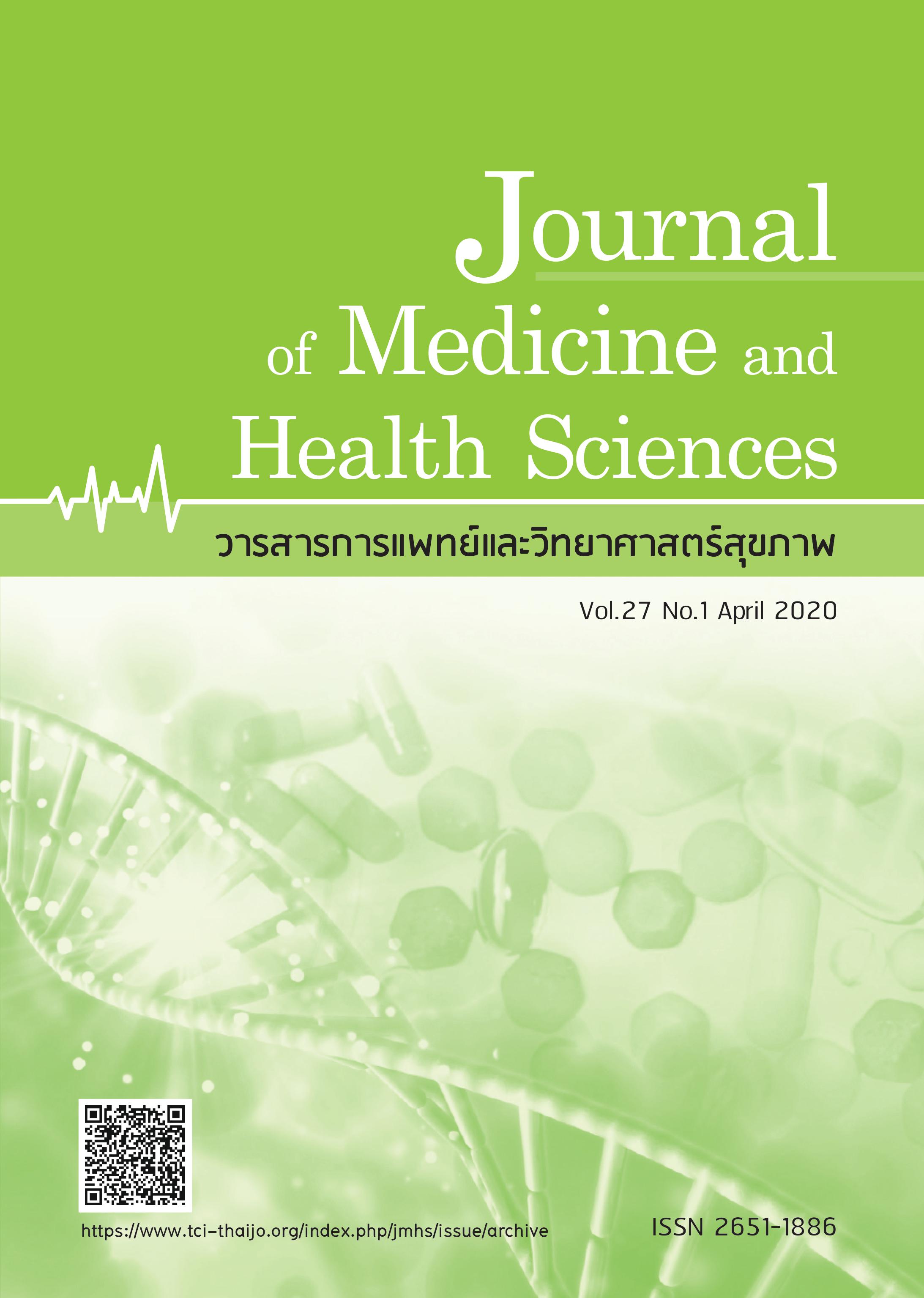The study of relationship of appropriate radiation dose following standard criteria and radiography exposure technique in Nongsung hospital, Mukdaharn province
Keywords:
radiography, exposure index, entrance skin doseAbstract
บทคัดย่อ
การวิจัยเชิงวิเคราะห์แบบภาคตัดขวางครั้งนี้ มีวัตถุประสงค์เพื่อศึกษาปริมาณรังสีที่ผิวหนังผู้ป่วยได้รับและค่าดัชนีชี้วัดปริมาณรังสี ในผู้มารับบริการรังสีวินิจฉัย หน่วยงานรังสีวิทยา โรงพยาบาลหนองสูง อำเภอหนองสูง จังหวัดมุกดาหาร โดยการบันทึกข้อมูล ความหนาของผิวหนังผู้ป่วย ค่าดัชนีชี้วัดปริมาณรังสีและค่าเทคนิคทางรังสี จากการ สุ่มกลุ่มตัวอย่างแบบมีระบบ จำนวน 200 คน จำแนกเป็นบริเวณทรวงอก ช่องท้อง กระดูกสันหลังส่วนล่างท่าด้านตรง (Anteroposterior; AP view) และกระดูกสันหลังส่วนล่างท่าด้านข้าง (Lateral view) ส่วนละ 50 คน คำนวณ หาปริมาณรังสีที่ผิวหนังของผู้ป่วย (Entrance skin dose; ESD) วิเคราะห์ข้อมูลโดยใช้สถิติพรรณนา ค่าเฉลี่ย ร้อยละ และ ส่วนเบี่ยงเบนมาตรฐาน และหาความสัมพันธ์ระหว่างความหนาของผิวหนังผู้ป่วยกับค่าเทคนิคทางรังสี และความสัมพันธ์ ระหว่างค่าดัชนีชี้วัดปริมาณรังสีกับปริมาณรังสีที่ผิวหนังของผู้ป่วยด้วยสถิติเชิงอนุมาน ได้แก่ Pearson‘s Correlation test กำหนดระดับนัยสำคัญทางสถิติที่ (p<0.05) ผลการศึกษาพบว่า ปริมาณรังสีที่ผิวหนังของผู้ป่วยได้รับจากการ ถ่ายภาพทางรังสีบริเวณทรวงอก ช่องท้อง กระดูกสันหลังส่วนล่างท่าด้านตรง และกระดูกสันหลังส่วนล่างท่าด้านข้าง มีค่าเฉลี่ย 0.19, 1.72, 1.76 และ 3.14 มิลลิเกรย์ ตามลำดับ ค่าดัชนีชี้วัดปริมาณรังสี เป็นไปตามค่ามาตรฐานที่บริษัท ผู้ผลิตกำหนด ร้อยละ 42, 24, 38 และ 72 ตามลำดับ ความหนาของผิวหนังผู้ป่วยกับค่าเทคนิคทางรังสี มีความ สัมพันธ์กันอย่างมีนัยสำคัญทางสถิติ (p<0.05) ค่าดัชนีชี้วัดปริมาณรังสีกับปริมาณรังสีที่ผิวหนังของผู้ป่วยบริเวณทรวงอกช่องท้อง กระดูกสันหลังส่วนล่างท่าด้านตรง ไม่มีความสัมพันธ์กันทางสถิติ (p>0.05) ค่าดัชนีชี้วัดปริมาณรังสีกับปริมาณ รังสีที่ผิวหนังของผู้ป่วยบริเวณกระดูกสันหลังส่วนล่างท่าด้านข้าง มีความสัมพันธ์กันอย่างมีนัยสำคัญทางสถิติ (r=0.133,p<0.001) ในการศึกษาครั้งนี้ปริมาณรังสีที่ผิวหนังของผู้ป่วยได้รับไม่เกินระดับปริมาณรังสีอ้างอิงในการถ่ายภาพทางรังสี ของทบวงพลังงานปรมาณูระหว่างประเทศ (IAEA)
Abstract
This cross-sectional analytic study aimed to assess the entrance skin doses and exposure index in patients undergoing diagnostic X-ray examinations at Nongsung hospital, Nongsung district, Mukadahan province. Patient thickness, exposure index and radiation technique were collected. Systematic random sampling was conducted to 200 patients in 4 types of X-ray examinations (50 patients per group) include chest X-ray, abdominal X-ray, lumbar spine AP view and lumbar spine lateral view. Calculate the amount of entrance skin dose. The data were analyzed using descriptive statistics, mean, percentage and standard deviation. Pearson’s correlation was used to identify the correlation of the patient thickness and the X-ray radiography technique, exposure index and surface entrance skin dose. The statistic test was conducted significant level at 0.05. The results showed that mean of entrance skin dose undergoing the chest X-ray, abdominal x-ray, lumbar spine AP view and lumbar spine lateral view were 0.19, 1.72, 1.76 and 3.14 milligray, respectively. Exposure index was in the range specified by the manufacture 42, 24, 38 and 72 percent, respectively. The correlation of the patient thickness and the X-ray radiography technique was statistically significant (p<0.05). Exposure index was not correlated with entrance skin dose undergoing chest X-ray, abdominal X-ray and lumbar spine AP whereas the correlation of exposure index and entrance skin dose of Lumbar spine Lateral view was statistically significant (r=0.133, p<0.001). The result of this study found that the mean of entrance skin dose was not exceeded standard of the international atomic energy agency (IAEA).
References
2. Huda W. RT X-ray physics review [Internet].Medical Physics Publishing. 2011. [cited 2019 Jan 20]. Available from https://books.google.co.th/books?id=kjZeXwAACAAJ.
3. Frija J, de Kerviler E, de Géry S, et al.Computed radiography. Biomed Pharmacother 1998;52(2):59-63.
4. Warren-Forward H, Arthur L, Hobson L, et al. An assessment of exposure indices in computed radiography for the posterioranterior chest and the lateral lumbar spine. Br J Radiol 2007;80(949):26-31.
5. Casali F, et. al. New x-ray digital radiography and computed tomography for cultural heritage in science for cultural heritage [Internet]. 2010. [cited 2018 Jun
25]:2010:85-99., Available from https://doi.org/10.1142/9789814307079_0008.
6. Seibert JA. Digital radiography: Image quality and radiation dose. Health Phys 2008;95(5):586-98.
7. Tootell A, Szczepura K, Hogg P. An overview of measuring and modelling dose and risk from ionising radiation for medical exposures. Radiography 2017;20(4):323-32.
8. Yensri L. Comparison of Radiation Absorded Dose among Patient Undergoing Standard Chest Radiographic Examination by Computed Radiography (CR) and Digital
Radiography (DR). SCN J 2016;3(1):129-39.
9. IAEA. IAEA Safety Standards Radiation Protection and Safety of Radiation Sources. 1996. Vol 3. Available from https://www-pub.iaea.org. [cited 2019 Jan27].
10. Jirawatkul A. Biostatistics for health science research. 2008. Khonkaen: Klung nana wittaya.
11. Kaenkaew B, Witchatorntakoon W,Awikunprasert P, et al. An Assessment of S value in Computed radiography for the posterior-anterior Chest of patients in Srinagarind hospital, Khonkaen university,Khonkaen: Faculty of Medicine, Khonkaen University. 2555;47(1):23-8.



